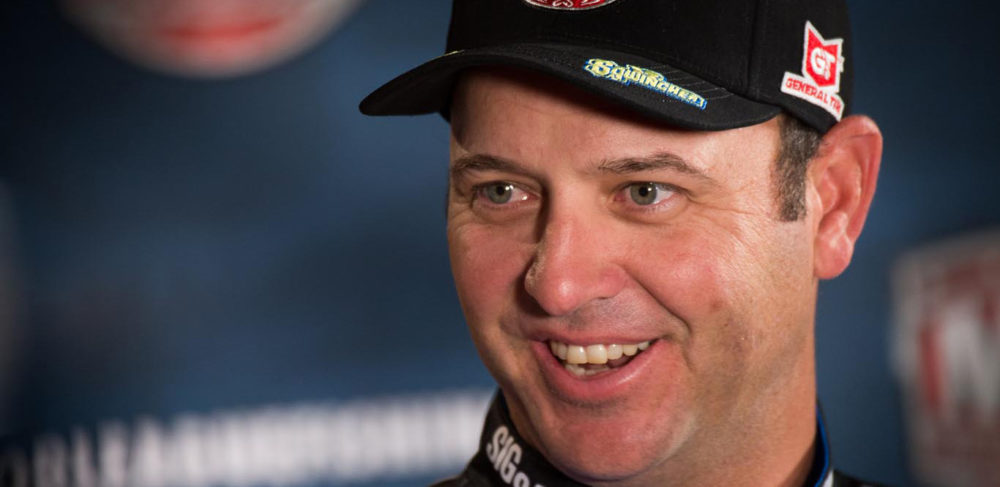Faircloth: Lure Selection Is Not Always What It Seems to Be

Happening upon seasoned Major League Fishing pro Todd Faircloth, it was easy to see that he was on the busy side of things in the pre-dawn gloom of a boat ramp just outside of Alpena, Mich.
Sitting in his crowded MLF bass rig, the East Texas pro hurriedly worked to finish up his rod-and-reel preparations while adjusting his final bait selections for the launch and subsequent first round.
When I counted the number of rod-and-reel setups on his front deck, I discovered that there was nearly a dozen in view. With many more waiting in rod boxes below.
Which led me to pose a question to Faircloth: are so many rods-and-reels necessary to capture a day’s worth of GEICO Select competition?
“Not necessarily,” said Faircloth, an East Texas pro who has played the MLF game for several years as an alternate, a GEICO Select pro and a MLF Cup-level qualifier.
“The deal here with MLF is that it’s a time deal,” he added. “We’re really crunched on time (out here) and instead of having to sit down and change baits, I can reach (on my deck or) in the rod box and pull (another) one out.”
Faircloth says that 10 or so rods on his front deck is a usual starting point for him, but certainly not a finishing point in terms of a day’s worth of fishing.
“Sure, I start with 10 rods or so on the deck,” said the 14-time Bassmaster Classic qualifier and winner of five B.A.S.S. events. “But by the end of the day, I’ll usually have it whittled down to five rods or so.”
Then he grinned and added with a hearty chuckle: “But if the day isn’t going so good, there might be 20 on the deck by the time we’re done.”
Faircloth said that multiple rods – and lure selections – can be a key for all anglers as they begin the day searching for what the fish are wanting.
He does note, however, that he isn’t necessarily talking about running with the first lure that produces a fish.
“You want to give different looks until you get a bite,” Faircloth said. “When you start getting some feedback (from the fish), a lot of times, you’re around (a group of fish). And because of that, a lot of times, I’ll change baits and see if there’s something better that they’ll react to.”
In Faircloth’s mind, a subtle danger for anglers is to get the wrong message from fish and to settle in on something too quickly.
“I think a lot of times, people will catch something on (a particular bait) and they kind of lock into it (too soon),” he said.

According to Faircloth, that can prove to be a mistake at times, especially if there’s a bait that the fish will respond to even better.
“I like to start off with a bait that I have a lot of confidence in,” he said. “Once I get a bite – and I know I’m around fish – that’s when I start experimenting. I start seeing if there is something better that they like.”
Noticing that Faircloth was tying on a Strike King Sexy Dawg topwater bait to one of his rod-and-reel set-ups, I asked if the lure’s color was as big a deal to him as amateur anglers like myself sometimes think that it is.
“I think color can make a big difference – at times,” Faircloth said. “(But other times) I think it’s more of a subtle deal. If they’re biting topwater, then generally, you can get a bite on some type of topwater (that is similar in color).”
“There’s generally one color that’s better than most others,” he continued. “When I’m searching for fish, I’ll start out with a color that I have confidence in. And then, once I find out that they’re on a topwater bite, I might experiment to see if there’s a (better and) different color.”
“I’ll take notice of whether or not they’re getting that bait all the way down into their throat,” said Faircloth. “Or are they missing the bait (just a little), hitting it short, stuff like that. If you’re noticing that, you probably need to experiment with different colors.”
Faircloth noted that sometimes, it’s not a color change that the fish want, it’s a change of retrieval speed, meaning that an angler can have the right lure – and the best color tied on – but they aren’t getting the results that they want.
“I (do) think a lot of times we jerk up the trolling motor too fast (and roar off somewhere else),” he added. “Once you’re on the lake (and have some practice time or ride-around time in MLF competition), you’re going to start on what you think is the best spot.”
“(So) before I jerk my trolling motor up and go to a different spot, I want to go through all of those (possible) different scenarios before I go to my second best spot,” he added.
“Usually, if it’s tough on your best spot, it’s going to be even tougher on your second best spot. So I think you need to go through all of those (possible) changes before you start running around.”
Work that is all a part of being a MLF pro, figuring bass out, adjusting to their daily whims and doing so better than any of the other pros on the water.